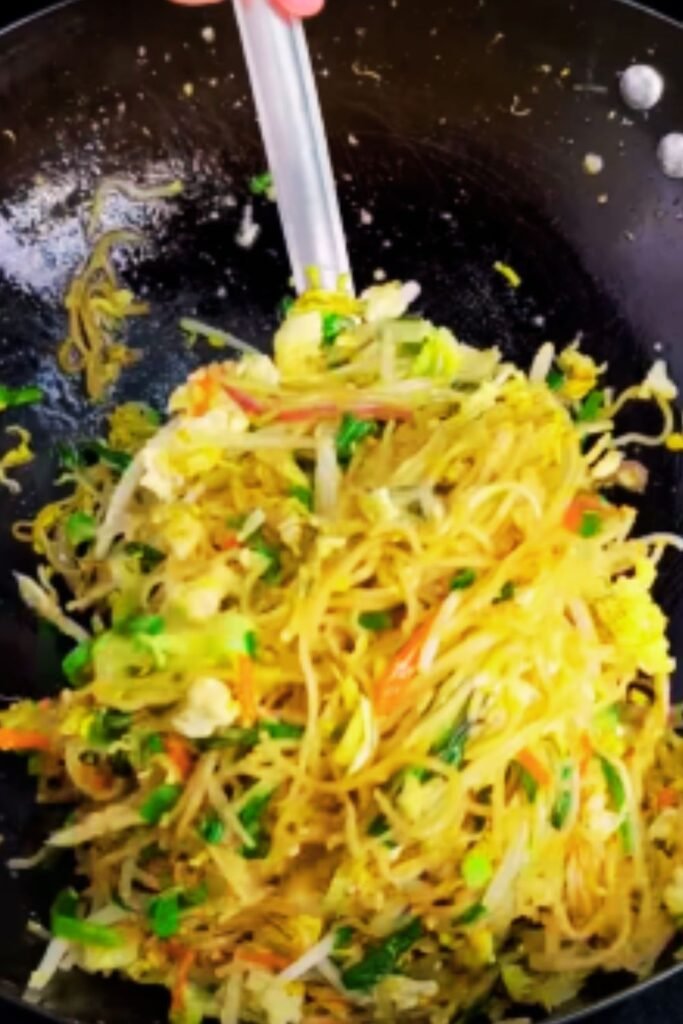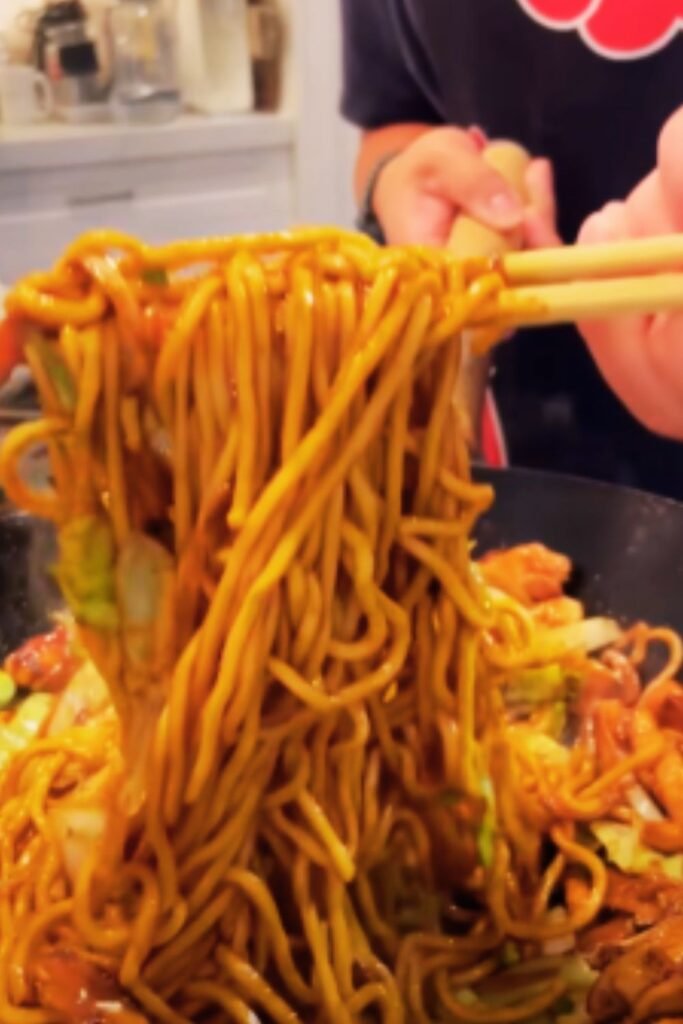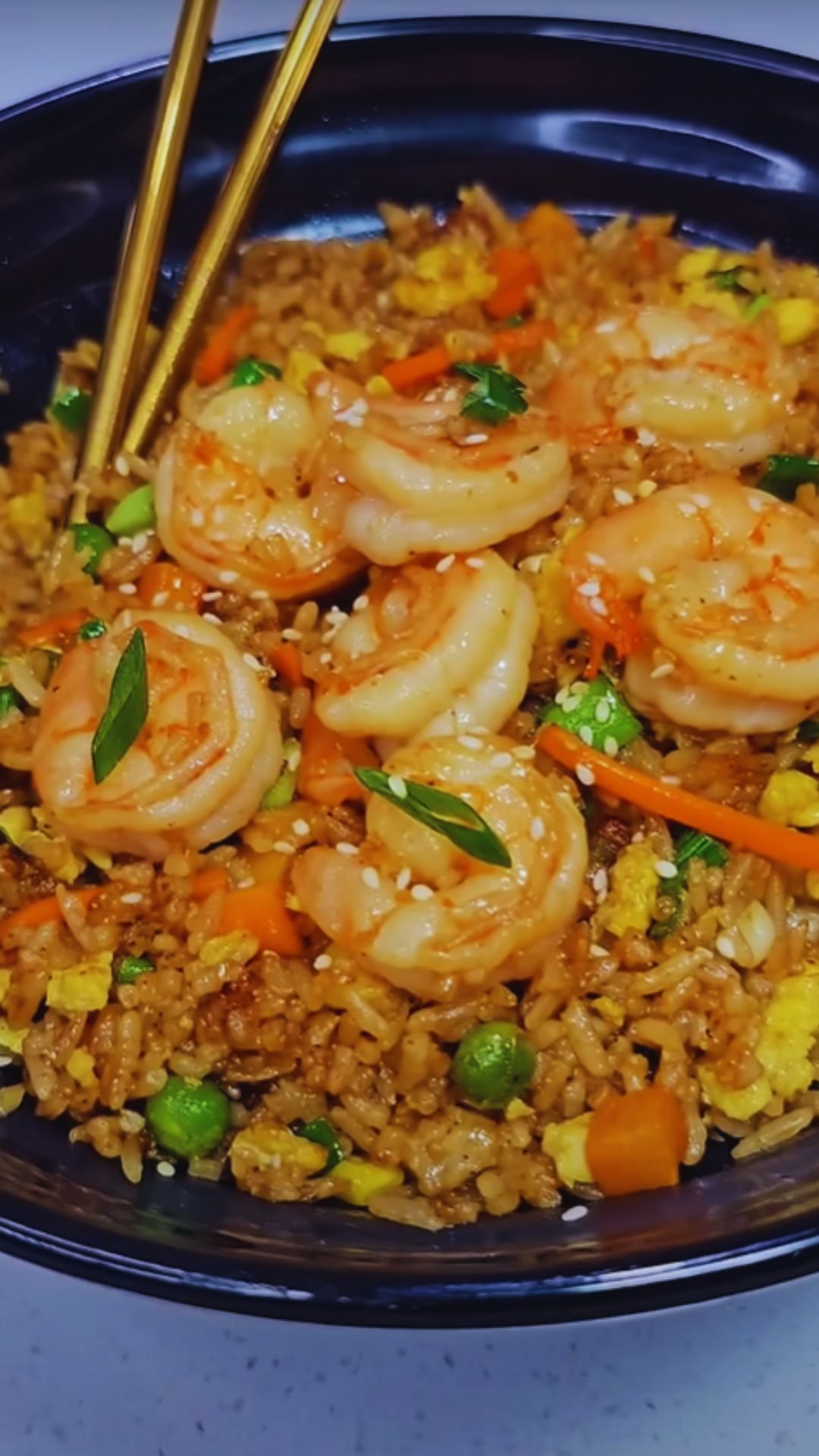There’s something magical about that sizzling plate of beef pan-fried noodles arriving at your table in a Chinese restaurant. The contrasting textures of crispy noodles and tender beef, the umami-rich sauce coating each strand—it’s a dish that captivates all your senses. For years, I believed this was restaurant-exclusive magic, but I was delightfully wrong. After countless attempts in my kitchen, I’ve perfected a recipe that brings that same restaurant experience right to your dining table.
Pan-fried noodles, or “chow mein” in Cantonese cuisine, showcase the beautiful art of Chinese stir-frying. The version I’m sharing today—beef pan-fried noodles—combines crispy egg noodles with tender marinated beef and stir-fried vegetables, all brought together with a savory sauce that will make you close your eyes in appreciation at first bite.
Whether you’re looking to recreate your favorite takeout dish or impress dinner guests with something special, this recipe delivers restaurant-quality results with accessible ingredients and straightforward techniques. Let me walk you through creating this showstopper dish step by step.
What Makes Beef Pan-Fried Noodles Special?
Before diving into the recipe, let’s understand what makes this dish so distinctive:
Hong Kong Style vs. American Style : Hong Kong-style pan-fried noodles feature a bed of crispy noodles topped with a stir-fried meat and vegetable mixture in sauce. The sauce slightly softens parts of the noodles while leaving others crispy, creating that signature textural contrast.
Wok Hei : This Cantonese term refers to the “breath of the wok”—that smoky, charred flavor that comes from cooking quickly at very high heat. While difficult to achieve on home stoves, I’ll share techniques to maximize flavor.
Balance of Textures : The magic lies in the contrast between the crunchy noodle base, tender beef, crisp vegetables, and silky sauce that brings everything together.
I’ve spent years perfecting this recipe, and while traditional recipes often call for equipment most home kitchens don’t have, my version delivers authentic flavors using standard kitchen tools and widely available ingredients.
Ingredients Breakdown
For the Beef Marinade:
- 1 pound flank steak or sirloin, sliced thinly against the grain
- 1 tablespoon soy sauce
- 1 tablespoon Shaoxing wine (or dry sherry)
- 1 teaspoon cornstarch
- ½ teaspoon baking soda (the secret to tender restaurant-style beef!)
- 1 teaspoon sugar
- 1 tablespoon vegetable oil
- 1 teaspoon sesame oil
For the Noodles:
- 1 pound fresh egg noodles (Hong Kong-style pan-fry noodles are ideal, but you can substitute with fresh yakisoba or thin spaghetti in a pinch)
- 3-4 tablespoons vegetable oil for frying
For the Vegetables:
- 2 cups bok choy, separated into leaves and stalks, chopped
- 1 medium carrot, julienned
- 1 small onion, thinly sliced
- 2 stalks celery, thinly sliced on a diagonal
- 8 shiitake mushrooms, stems removed and sliced
- 2 cloves garlic, minced
- 1-inch piece ginger, peeled and julienned
For the Sauce:
- ¼ cup oyster sauce
- 2 tablespoons light soy sauce
- 1 tablespoon dark soy sauce (for color)
- 1 teaspoon sugar
- ½ cup chicken stock or water
- 1 tablespoon cornstarch mixed with 2 tablespoons water (slurry)
- White pepper to taste
For Garnish:
- 2 green onions, sliced on a diagonal
- 1 teaspoon toasted sesame seeds
- Cilantro leaves (optional)
Ingredient Selection Tips
Beef Choice : Flank steak is my go-to for its perfect balance of flavor and tenderness when properly sliced. Sirloin works well too. The key is slicing very thinly against the grain—I often partially freeze my beef for 20-30 minutes to make this easier.
Noodle Options : Authentic Hong Kong-style egg noodles are thin and designed specifically for pan-frying. If unavailable, fresh yakisoba noodles (without the seasoning packets) make a good substitute. In a pinch, I’ve even used thin spaghetti or angel hair pasta—not traditional but satisfying in a different way.
Vegetable Variations : The vegetables listed are classic choices, but this dish welcomes substitutions. Snow peas, bell peppers, or bean sprouts all work beautifully. The key is maintaining a variety of colors and textures.
Sauce Ingredients : If you don’t have dark soy sauce, you can use all light soy sauce and add a touch of molasses for color. Vegetable stock can replace chicken stock for a vegetarian version of the sauce.

Preparation Steps
Marinating the Beef
- Slice your beef against the grain into very thin pieces, ideally no more than ⅛-inch thick.
- In a bowl, combine all marinade ingredients and mix well.
- Add the beef slices and massage the marinade into the meat with your hands (I recommend wearing gloves).
- Cover and refrigerate for at least 30 minutes, preferably 1-2 hours.
Preparing the Vegetables and Sauce
- While the beef marinates, prepare all your vegetables and arrange them on a plate in the order they’ll be added to the wok.
- Mix all sauce ingredients except the cornstarch slurry in a small bowl.
- In a separate small bowl, create your cornstarch slurry by mixing cornstarch and water until smooth.
Pre-Cooking the Noodles
- If using fresh egg noodles, loosen them gently with your fingers. If they’re very tightly packed, rinse briefly under warm water and drain thoroughly.
- If using dried noodles, cook them for 1 minute less than package directions, drain, and rinse under cold water to stop the cooking process.
- Dry the noodles thoroughly by spreading them on a kitchen towel or using a salad spinner.
Cooking Method
Step 1: Crisping the Noodles
- Heat a large wok or 12-inch skillet over medium-high heat until hot.
- Add 2 tablespoons of oil and swirl to coat the surface.
- Spread the noodles in an even layer, pressing down slightly with a spatula.
- Allow to cook undisturbed for 3-4 minutes until the bottom becomes golden and crispy.
- Carefully flip the noodle cake in sections (don’t worry if it breaks a bit).
- Add another tablespoon of oil around the edges and cook for another 2-3 minutes until the other side crisps up.
- Transfer the crispy noodle cake to a serving plate and keep warm.
Step 2: Stir-Frying the Ingredients
- Return the wok to high heat and add 1 tablespoon of oil.
- When the oil is shimmering and just starting to smoke, add the marinated beef in a single layer.
- Allow it to sear undisturbed for 20-30 seconds before stir-frying quickly until the beef is 80% cooked through (about 1-2 minutes).
- Transfer the beef to a clean plate and set aside.
- If needed, add another teaspoon of oil to the wok, then add garlic and ginger. Stir-fry for 10 seconds until fragrant.
- Add onions and stir-fry for 30 seconds.
- Add carrots and celery, stir-frying for another minute.
- Add mushrooms and the white parts of the bok choy, stir-frying for about 1 minute.
- Finally, add the leafy green parts of the bok choy and stir-fry until just wilted.
Step 3: Creating the Sauce and Combining
- Pour the sauce mixture into the wok with the vegetables and bring to a simmer.
- Give your cornstarch slurry a quick stir and add it to the simmering sauce, stirring constantly.
- Once the sauce begins to thicken (about 30 seconds), return the beef to the wok and stir to combine.
- Cook for another 30 seconds until everything is well-coated and heated through.
Step 4: Assembly and Serving
- Pour the beef, vegetable, and sauce mixture directly over the crispy noodle cake.
- Garnish with sliced green onions, toasted sesame seeds, and cilantro if using.
- Serve immediately while the contrast between crispy and saucy noodles is at its peak.

Cooking Tips and Tricks
Getting Restaurant-Quality Beef
The baking soda in the marinade is my secret weapon for achieving that tender, velvety texture you find in Chinese restaurants. It’s a technique called “velveting” that changes the pH of the meat’s surface, preventing the proteins from bonding too tightly during cooking.
Maximizing “Wok Hei” Flavor
True wok hei requires the intense heat of professional burners, but you can approximate it at home:
- Make sure your wok or pan is very hot before adding ingredients
- Cook in small batches to maintain temperature
- Keep ingredients moving constantly
- Don’t overcrowd the pan, which lowers the temperature
Noodle Perfection
For extra-crispy noodles, I sometimes pre-cook fresh noodles by boiling for just 10-15 seconds, then rinse under cold water, drain thoroughly, and toss with a teaspoon of oil before pan-frying.
Sauce Consistency
The perfect sauce should coat the back of a spoon but still flow easily. If your sauce becomes too thick, add a tablespoon of water or stock. If it’s too thin, mix a little more cornstarch with water and add gradually.
Troubleshooting Common Issues
| Problem | Possible Cause | Solution |
|---|---|---|
| Beef is tough | Sliced with the grain instead of against it | Always slice perpendicular to the visible muscle fibers |
| Overcooked | Cook beef very quickly at high heat, removing when just barely done | |
| Noodles aren’t crispy | Too much moisture in noodles before frying | Dry thoroughly after rinsing; use a kitchen towel or salad spinner |
| Pan not hot enough | Ensure pan is properly heated before adding noodles | |
| Noodles too thick | Spread noodles in a thinner layer | |
| Sauce is too thin | Not enough cornstarch | Mix additional cornstarch slurry and add gradually |
| Didn’t let it simmer enough | Allow sauce to bubble and thicken properly | |
| Sauce is too thick | Too much cornstarch | Add a bit of stock or water to thin it out |
| Vegetables are soggy | Cooked too long | Add vegetables in order of cooking time needed; leafy greens go in last |
| Pan not hot enough | Maintain high heat throughout stir-frying |
Variations to Try
Protein Swaps
- Chicken: Substitute thinly sliced chicken breast, using the same marinade but reducing marinating time to 20-30 minutes.
- Shrimp: Skip the marinade except for a little cornstarch, salt, and white pepper. Cook shrimp for just 1-2 minutes.
- Tofu: For a vegetarian version, use extra-firm tofu, pressed and sliced. Pan-fry separately until golden before adding to the stir-fry.
Regional Adaptations
- Singapore Style: Add 1 teaspoon of curry powder to the sauce for a distinctive flavor.
- Sichuan Style: Include 1-2 dried red chilis and 1 teaspoon of Sichuan peppercorns for a numbing, spicy kick.
- Cantonese Style: Add a few drops of sesame oil and a splash of fish sauce to the final sauce for extra umami depth.

Serving Suggestions
Make your meal complete with these complementary dishes:
- Hot and Sour Soup as a starter
- Steamed dumplings as an appetizer
- Cucumber salad with rice vinegar and sesame oil as a refreshing side
- Fresh fruit like orange slices or lychees for dessert
- Jasmine tea or iced tea to drink
For a family-style Chinese feast, consider adding:
- Mapo tofu
- Chinese broccoli with oyster sauce
- Steamed rice for those who might want some
- Sweet and sour chicken for variety
Make-Ahead and Storage Tips
Preparation in Advance
- Marinate beef up to 12 hours ahead (store in refrigerator)
- Slice vegetables up to a day ahead and store in airtight containers in the refrigerator
- Mix sauce ingredients (except cornstarch slurry) up to 2 days ahead
- The cornstarch slurry should always be made just before cooking
Storing and Reheating
While this dish is best enjoyed immediately after cooking, leftovers can be stored:
- Refrigerate in an airtight container for up to 2 days
- Reheat in a skillet with a splash of water over medium heat
- The noodles won’t retain their original crispiness, but they’ll still be delicious
I don’t recommend freezing this dish as the texture of both noodles and vegetables significantly deteriorates.
Health and Nutrition Information
Beef pan-fried noodles can be part of a balanced diet when enjoyed in moderation. Here’s a breakdown of the nutritional highlights:
| Component | Amount per Serving (approximate) | Notes |
|---|---|---|
| Calories | 450-550 | Varies based on oil used and portion size |
| Protein | 25-30g | Primarily from beef |
| Carbohydrates | 50-60g | Mainly from noodles |
| Fat | 15-20g | From cooking oil and beef |
| Fiber | 3-5g | From vegetables |
| Sodium | 800-1000mg | Can be reduced by using low-sodium soy sauce |
Making It Healthier
- Use less oil for frying noodles (try a non-stick pan to reduce need for oil)
- Increase the vegetable-to-noodle ratio
- Choose lean cuts of beef and trim visible fat
- Use low-sodium soy sauce and broth
- Add more vegetables for extra fiber and nutrients
Frequently Asked Questions
Can I make this dish gluten-free? Yes! Use rice noodles instead of egg noodles and ensure your soy sauce and oyster sauce are gluten-free varieties (tamari is a good gluten-free soy sauce alternative). For the oyster sauce, look for gluten-free labeled products or make your own with gluten-free ingredients.
What if I can’t find Shaoxing wine? Dry sherry is the best substitute. In a pinch, you can use white wine with a pinch of sugar, or even omit it altogether and add a splash of rice vinegar for acidity.
How spicy is this dish? As written, this recipe is very mild. If you enjoy heat, add sliced fresh chilies or chili oil to taste. Some diners prefer to add their own chili sauce at the table.
Can I use beef that’s already sliced for stir-fry from the supermarket? Yes, but it’s often not sliced thinly enough. If using pre-sliced beef, you might want to slice it further into thinner pieces for the best texture.
Why is my beef not getting that special restaurant tenderness? Don’t skip the baking soda in the marinade—it’s crucial for tenderizing. Also ensure you’re slicing against the grain and not overcooking the beef.
Can I make this in a regular skillet if I don’t have a wok? Absolutely! A large 12-inch skillet (preferably stainless steel or cast iron) works well. You may need to cook in smaller batches to maintain proper heat.
Final Thoughts
Creating restaurant-quality beef pan-fried noodles at home is achievable with the right techniques and a bit of practice. Don’t be intimidated by the multiple steps—once you’ve made this dish a couple of times, the process becomes intuitive and even meditative.
What I love most about this recipe is its versatility. The core techniques remain the same, but you can adapt the protein, vegetables, and sauce to suit your preferences or what you have on hand. It’s also an impressive dish to serve guests, with its dramatic presentation and complex flavors that belie the relatively straightforward preparation.
Remember that the hallmark of great pan-fried noodles is texture contrast—crispy meets tender, with a savory sauce bringing everything together. Even if your first attempt isn’t perfect, it will surely be delicious, and each time you make it, you’ll get closer to mastering this classic dish.
Now that you have all the details and insider tips, it’s time to heat up that wok and bring the flavors of a Chinese restaurant into your kitchen. Happy cooking!


